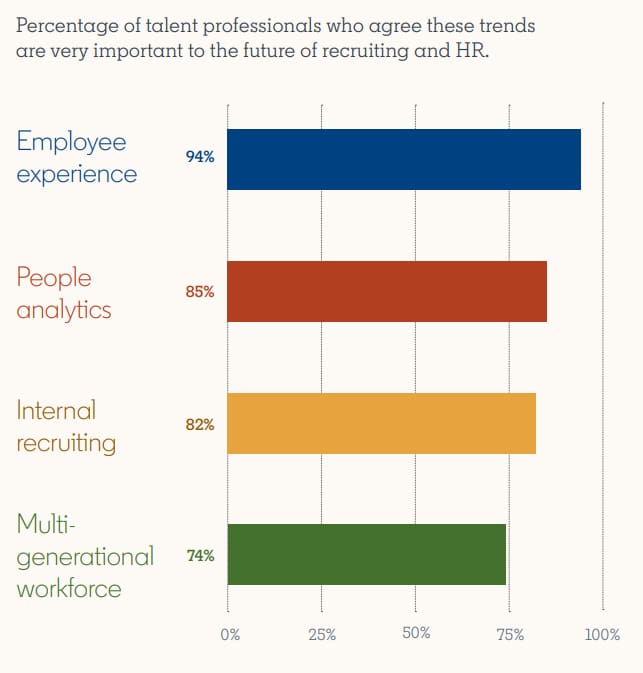Recently spotted want ad: U.S. manufacturer that consistently makes the Forbes list of America’s best employers seeks talent analyst. Ideal candidate will continue the growth of the company’s talent programs and establish consistent metrics across business units. Must have a user-centric mindset and be creative, innovative and collaborative.
Those adjectives — especially “user-centric”— sum up the future of talent management. In fact, demand for HR pros with analytics skills is sky-high: 73% of more than 7,000 respondents to LinkedIn’s 2020 Global Talent Trends report said that people analytics will be a major priority for their companies over the next five years. There’s already been a 242% increase in HR professionals with data analysis skills over the past five years.
To bake analytics into your human capital management practice, begin by identifying the KPIs and metrics that will help accelerate your organizational goals.
Analytics Skills In Demand

What Are Talent Management KPIs?
Talent management refers to the way in which a company puts together the best workforce for its business model and continues to develop and meet the individual motivations and needs of employees so that they stay with the company.
Talent management KPIs power those efforts by measuring the effectiveness of the functions and processes HR teams use to attract, develop, retain and deploy employees with the necessary skills and aptitude to meet the business’ current and future needs.
Why Measure Talent Management KPIs?
There are obvious reasons for measuring the effectiveness of talent management processes. People are the biggest expense for an organization, so it makes sense to look at better ways to manage personnel costs. KPIs drive out waste, make processes more efficient and guide organizations looking to recalibrate to hit goals. Tracking KPIs helps organizations get insights that enable them to provide a better employee experience.
The Top 5 ways LinkedIn’s 2020 Talent Trends survey respondents employ people analytics: Measuring employee performance, strategic workforce planning, identifying skills gaps, evaluating recruiting channels and assessing talent supply and demand.
They’re also eying ways to reduce bias in hiring and promotions and identify flight risks to improve retention.
How to Implement Talent Management Metrics
While actual data itself will vary, many of the formulas and metrics that measure talent management are universal across industries. For that reason, robust HCM software can automate the process of tracking and analyzing KPIs.
But many organizations struggle with analyzing and acting on the information they so painstakingly gather. Just 39% of LinkedIn’s talent professional respondents say they can draw meaningful insights from data. They also struggle to act on insights to solve existing problems and take advantage of new opportunities.
Start the people analytics journey by selecting a few key metrics in areas where the company wants to see improvements. Is turnover high in a particular function? Are there troubling trends in demographics?
Then, align KPIs to your problem areas and begin gathering data.
15 Top Talent Management KPIs and Metrics to Measure
Data for some KPIs, like turnover and demographic breakdown, are relatively straightforward to gather. Factors like performance and employee satisfaction will be harder to measure, but it’s this more in-depth data that can provide an edge to business decision-makers.
1. Turnover: Tracking leavers is hugely important because turnover rates provide clues about weaknesses in multiple facets of the talent management process.
Turnover Rate = # of Separations / Avg. # of Employees x 100
Calculate both voluntary turnover — how many people left the company on their own accord — and involuntary turnover, which measures how many were let go. Another important metric is high-performer turnover, which measures the loss of top employees based on performance metrics.
2. Retention: Retention is more than the flip side of turnover in that it focuses only on the employees the company wants to keep by stripping away people who were terminated for whatever reason.
Retention rate = Number of employees remaining at the end of the period / total number of employees
Dig in deeper by calculating retention rate by manager, location or department. Gallup estimates that manager performance account for 70% of the variance when it comes to employee engagement scores. This makes sense — managers are charged with providing mentoring and support to help workers reach their full potential. This can’t happen if the manager is unavailable or disengaged. A lower-than-company-average retention rate at one location or in a particular department likely indicates a problem. When HR identifies blips, they can prompt managers to enter into conversations, provide feedback and work to more deeply engage employees.
3. Employee satisfaction: This metric directly impacts retention and is often measured via surveys and one-on-one conversations with managers. While it’s less straightforward than turnover or retention, there are ways to put numbers around employee satisfaction.
For instance, employee engagement surveys now offer a way to measure so-called employee Net Promoter Scores (eNPS). Like a traditional NPS, an eNPS provides a standardized way to measure how employees feel about the company.
An eNPS survey asks: “On a scale of zero to 10, how likely is it that you would recommend this organization as a place to work?" Promoters give scores of 9 and 10, detractors give scores from 0-6, and scores in between are considered “passives.” Subtract the percentage of detractors from promoters to get your eNPS.
If a survey isn’t feasible, standardize how managers conduct periodic check-in conversations. Every quarter, supervisors should ask a set of questions and record responses. For example: What do you like about your job? Do you feel the company as a whole is on the path to growth? Do you think your team works together well? Where do you see yourself in five years?
But be aware that anonymous surveys are more likely to deliver a frank assessment of satisfaction.
4. Performance: There are many ways to measure performance. Among the most popular:
- New-hire failure rate: This is the percentage of new employees who leave the company within a particular time period, typically a year. It speaks volumes about whether the recruiting team is finding the right people for open roles.
- Quality of hire: Organizations measure the quality of hires by using a combination of performance appraisal scores and retention rate.
- Work quality: How well are employees meeting objectives set by managers? Or, in industries like manufacturing or finance, tap into stats on product defects or accounting errors.
5. Distribution: Do you have a demographically distributed workforce in terms of age, gender and other factors? Distribution calculations can be part of a diversity, equity and inclusion (DE&I) project.
A formal DE&I program is a strategic and financial advantage for businesses — and it’s becoming a priority for people when considering employers. For instance, Glassdoor now has a rating for workers' satisfaction with DE&I at current and former companies.
SHRM points out that DE&I extends beyond gender to all qualities, experiences and work styles that make individuals unique, such as race, age, religion, disabilities and ethnicity, as well as how organization can leverage those qualities in support of business objectives.
Don’t just look at hiring. Add diversity to retention calculations, perhaps beginning with women and employees of color to see if they’re leaving at a greater rate than others. Also look at diversity metrics across hiring managers and locations and in context of advancement.
6. Mobility: When businesses turn inward to find talent they not only save on recruiting costs, they boost morale because employees see that they have paths for career growth. LinkedIn says that role changes within organizations via promotion, transfer or lateral move have increased steadily over the last five years because it’s simply more cost-effective.
One way to measure mobility and the success of internal recruiting programs is through a Career Path Ratio, a way to measure internal movement into lateral or higher positions in the company.
Career path ratio: Total promotions/(total promotions + total transfers)
Values above .7 show vertical promotions are high, while under .2 shows lateral transfers are high.
Speaking of lateral moves, make very clear that there will be no retaliation for an employee who chooses to apply for a new position within the company. If a worker fears losing a current job or being ostracized by her team or supervisor, your mobility KPIs will remain low.
7. Training spend: As companies adopt more technology, they can either help employees keep pace or deal with turnover as people become discouraged. It’s no surprise then that one-third of the 1,675 learning and development professionals taking part in LinkedIn’s 2020 Workplace Learning Report(opens in new tab) plan to increase training budgets this year, with more than half planning an increase in online learning.
While 2020 training budgets necessarily included safety and compliance-related education, organizations must also focus on reskilling employees for new roles and realities.
Some data to benchmark your spending against peers comes from the Training Industry Report(opens in new tab). Overall, on average, companies spent $1,286 per learner in 2019 compared with $986 per learner in 2018. Nonprofits spent the most ($1,889) followed by manufacturers/distributors ($1,781). Midsize companies spent less ($829) than both large ($1,544) and small ($1,511) companies.
8. Continuing education/skills gap: The good news on that spending: Companies with comprehensive training and reskilling programs have 53% lower attrition than competitors that don’t invest in education, according to LinkedIn’s Global Talent Trends Survey. Gen Z workers are most likely to value training — 36% call it a top factor when considering a new job.
To justify the time and financial costs of training programs, HR must devise ways to track effectiveness. One way to do that is by measuring engagement by calculating course completions, deploying learner satisfaction surveys and tracking minutes of learning per month. Those that pay for outside training should ask for deliverables that feed into this KPI.
Companies can also map engagement numbers to people-centric business results. For instance, did an increase in engaged learners result in safety improvements and a lower total recordable incident rate? Is there a connection over time between learning engagement and retention, profitability or customer satisfaction?
9. Cost to hire: The cost-per-hire metric measures the cost-effectiveness of your recruiting operation. The goal: Hire the best talent, in the shortest period of time, for the least expense.
A basic average cost-per-hire can be calculated by dividing total external and internal hiring costs by the number of hires in a specified time period. External costs include third-party agency fees, advertising, job fairs and any other costs to reach candidates. Internal costs include the fully loaded salaries and benefits of the recruiting team plus fixed costs, such as a talent acquisition system.
SHRM data shows that in 2017, on average, all new hires cost $4,425, the average executive cost per hire was $14,936 and the average number of requisitions per recruiter was 29.
10. Time to hire: Along with time to fill positions, time to hire captures the span of the entire hiring process, from job requisition to candidate acceptance. Time to fill is the time from requisition to hire, while time to hire is the time from when eventual successful candidates entered the talent pipeline to when they accepted an employment offer.
Both metrics are helpful to set hiring expectations with managers, define recruiter goals and workloads and tease out areas of process improvement. Time to hire will be affected by scarcity — or abundance — of talent, meaning companies need to normalize their year-over-year comparisons based on their own realities.
HR teams should be diligent about tracking time to hire because there are significant costs to a lengthy hiring process — current employees become burned out, and productivity may decline. A drawn-out or inefficient fill process can lead to the loss of good candidates and the need to start over. Identify bottlenecks in the process, like getting feedback from hiring managers, and fix them. Then continue to drive out inefficiencies.
11. Yield ratio: Yield ratios measure the efficiency of an organization's hiring process. While there are different types of yield ratios, the goal is to track how many candidates are needed to get a qualified hire. Stages include:
- Applicant-to-interview-offer yield ratio
- Interview-to-job-offer yield ratio
- Job-offer-to-hire yield ratio
Say you advertised for a CPA.
Applicant to interview: Of 50 applicants, you screen out 30 immediately because these applicants lacked the proper credential. The hiring manager rejects an additional 10 for various reasons and asks to speak with the remaining 10.
Interview to offer: After three weeks of interviews, you issue an offer to the top candidate.
Offer to hire: Say the manager’s top choice makes a counter-offer on salary but ultimately declines, a process that took four days. Now you move to the second choice, who accepts in one day.
12. Time to full productivity: This is not an exact metric. It has three drivers that measure the effectiveness of different departments: The level of experience of the candidate and how well the onboarding program worked reflect on HR, while how supported the new hire is day-to-day is more about the manager and team.
Companies need to decide on how they’ll define productivity and then measure each step. For instance, productivity could be defined as being able to work effectively independently.
13. Absenteeism: Organizations that measure how many unplanned absences an employee has over a given period of time can spot flight risks and intervene to potentially keep the worker and lower their turnover rates.
A traditional measure of absenteeism is the Bradford score: B= S2 x D, where B = Bradford factor score, S = total number of spells (instances) of absence for that individual in the given period and D = total number of days the individual was absent during the given period.
14. Vacation earned and used: Measuring the paid-time-off (PTO) hours taken by employees as a percentage of the total number of paid-time-off hours available and paid for shows whether employees are taking advantage of the time off they’ve earned.
Also known as “PTO utilization rate,” HR teams should compare this metric by department to find discrepancies among teams and managers. If employees are not taking PTO, find out why not — they may be overloaded and headed for burnout.
If HR is not regularly tracking PTO per employee, the finance team will have difficulty calculating what’s owed to leavers in their final paychecks.
PTO utilization rate: Total number of PTO or vacation days taken / Total number of PTO or vacation days available.
15. Exit interviews: Most companies perform exit interviews — what varies is how successfully they analyze and act on what they learn. HR teams should take the lead in fashioning an effective EI strategy. Top goals: Reveal the channels employees use to find new jobs and specific reasons for leaving; determine where workers are going, to see if a competitor is poaching talent; spot poor managers and intervene; and determine whether a lack of training or advancement opportunities are driving away talent.
Some best practices:
- Use a standard survey with a follow-up face-to-face or phone interview. That way, HR can zero in on a few factors, and the company has a record of key information.
- Consider using an external contractor to perform exit surveys and interviews. Leaving employees may be more frank with a consultant.
- Confirm that all conversations will be kept confidential, no matter who performs the interview.
- Document findings from the interview immediately.
Talent Management KPI Examples
Technology has made gathering the data to track talent management KPIs easier — but acting on and making proactive decisions based on that data still eludes many organizations.
One way to make sure data becomes actionable is to surface it on a human resources management system (HRMS) dashboard, where you can see real-time data on headcount, growth and turnover trends, with all calculations automated.
On a larger scale, great talent management KPIs allow the business to ask: Why is this happening and what can we do about it? For instance, in analyzing turnover, the business can further drill down to see if turnover differs by demographic characteristics, functions of the business, teams and managers. If there are trends, management can dig into and address the reasons.
LinkedIn’s 2020 Talent Trends Report(opens in new tab) points to a great, real-life example in Discovery Limited. In 2017, it implemented talent analytics with the aim of lowering attrition among its workforce of 16,000 people. To that end, The South Africa-based international financial services organization built a “human capital dashboard” which captured data on organizational structure, headcount, demographics, recruitment, retention, employee engagement, diversity and inclusion, employee well-being, compensation and more.
By tracking KPIs around these metrics, the dashboard makes it easy to drill down into attrition by a lot of different criteria — top performers, critical skills, demographic trends and overall turnover and recruitment costs. Employees can now be flagged as “flight risks,” and have managers step in to help. Attrition has been reduced to below 12% from 16% three years ago, and now, the company is employing a machine learning model to improve predictions and boost accuracy.
Tracking and Measuring Talent Management KPIs with HR Software
Many organizations are seeing big gains by making small changes around intangible factors that are more difficult to measure, such as the employee experience. For instance, as a part of all of the functionality that comes with a full-fledged HRMS, NetSuite’s SuitePeople gives employees an easy way to recognize their colleagues for contributions and achievements, and to foster a positive work culture. Employees can access the functionality within the NetSuite interface and award kudos to individuals. The software offers the ability to configure the kudos to unique organizational goals and values.
For instance, NetSuite SuitePeople and its “Kudos” functionality give companies the ability to automate employee recognition, making it more visible and seamless, and in the process, increasing participation rates. Employees are in NetSuite for project management, PTO requests and time sheet management, and they're therefore more likely to send recognition.
Small changes can have big results. Having the right talent management KPIs in place empowers HR teams and business managers to identify challenges and make adjustments before they lose top employees.







